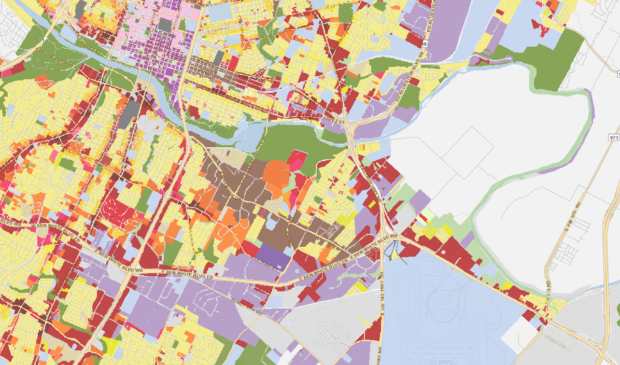Council responds to code second draft
Wednesday, February 5, 2020 by
Ryan Thornton City Council took a few hours Tuesday afternoon to respond to the second draft of the revised Land Development Code in light of a new zoning map, a recalibrated density bonus program and reduced overall housing capacity.
Last Friday, Jan. 31, the city’s Land Development Code revision team released the draft after consideration of 199 amendments from Council, city staffers and the Planning Commission.
Since Council’s first reading approval in December, the rewrite team has made several decisions to reduce the overall capacity of smaller multifamily – or “missing middle” – housing types and move those into other parts of the city where they may be less controversial.
At the same time, the team has revised the code’s affordable housing bonus program, incorporated Mayor Pro Tem Delia Garza’s concept of the equity overlay in East Austin and tried to increase housing capacity in activity centers and along major corridors.
As with the previous draft, Council focused much of its attention Tuesday on the mapping and capacity of missing middle housing.
Council Member Pio Renteria regretted what he considered to be lost opportunities for missing middle housing types in his district due to the rewrite team’s choice to zone most lots approximate to their current entitlements.
Annick Beaudet of the rewrite team said Council members will eventually be able to take specific areas through a separate planning process if there are places where they see demand and need for zoning changes not reflected in the code map.
“The code is not static,” Beaudet said. “We are going to create the tools, we are going to apply it comprehensively with the map, and then we need to do next-level planning to continue to refine using those tools that we’ve created.”
The code’s second draft features significant changes to overall missing middle housing capacity, with some Council districts losing as much as a few thousand units due to downsized transition zones. Following portions of Council direction, the code team is proposing to reduce or eliminate missing middle housing in areas vulnerable or undergoing early stages of gentrification, along primarily residential corridors, and in areas potentially impacted by localized flooding (areas not in the floodplain but still vulnerable).
Even so, several Council members argued that the draft hasn’t gone far enough to protect neighborhoods from the pressures of redevelopment.
Council Member Kathie Tovo said that while she appreciates the team’s decision to replace many missing middle zones like residential 4 (R4) with even lower-density zones, that hasn’t resolved the issue in her district of transition zone mapping that goes well beyond the two- to five-lot depth used as a general measure.
Council Member Alison Alter said that the decision to move some of the missing middle zones out of transition areas and into high-opportunity areas still represents a problem for neighborhood residents.
Noting the rewrite team’s expectation that a rather small percentage of total housing supply is likely to come out of these missing middle zones, Alter said it may be better simply to not rezone those lots and stop creating so much angst in some neighborhoods.
“The transition zones are what is giving everyone the heartburn and we really have to understand how little we’re getting from these transition zones,” she said. “And they’re going to not just create heartburn now, it’s going to create challenges for folks moving forward as the neighborhoods change.”
Mayor Steve Adler countered that if there truly is going to be so little added supply from these zones, as the rewrite team predicts, then they won’t be such disruptive forces after all, even for those who wish to preserve the character of their low-density neighborhoods.
Council Member Greg Casar said he could accept the push to move capacity away from low-density neighborhoods and into activity centers and corridors as long as the city focuses on “buildability” for those units, making sure that if total capacity is going to decrease from the first draft, the remaining capacity will at least be likely to produce new housing supply.
Council was also unsure what to think about the conditions of the East Austin equity overlay, a zoning district intended to protect existing housing supply and prevent further displacement. The overlay would require Council’s approval and give neighborhoods an opportunity to discuss developments wishing to take part in the density program.
Alter said that potentially could make getting affordable housing more complicated, while the city is trying to make it simpler. Council Member Ann Kitchen added that she wasn’t sure how the program actually protected and preserved existing housing supply.
Council Member Jimmy Flannigan, however, said the code should not be thought of as a preservation tool when residential properties today are being replaced by more expensive developments without any changes in zoning.
“Today’s condition is not viable,” Flannigan said. “Change is inevitable; I worry about trying to use this process as a tool to preserve existing construction when I don’t know that that’s a doable act.”
Map courtesy of the city of Austin.
The Austin Monitor’s work is made possible by donations from the community. Though our reporting covers donors from time to time, we are careful to keep business and editorial efforts separate while maintaining transparency. A complete list of donors is available here, and our code of ethics is explained here.
You're a community leader
And we’re honored you look to us for serious, in-depth news. You know a strong community needs local and dedicated watchdog reporting. We’re here for you and that won’t change. Now will you take the powerful next step and support our nonprofit news organization?









